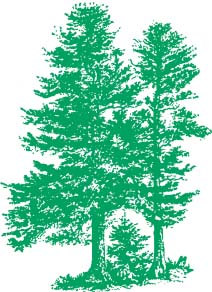 |
|
 |
|
 Although the press release for the 1999 inventory report (released two weeks before the election) stated proudly that the results show that there is not a "crisis," a quick glance at this document shows that there are grounds for continuing concern. It is difficult to come up with any significant statement on major trends in the woods, however, because of the following: It is only 4 years between 1995 (the last USDA survey) and 1999. Forests do not normally change significantly in four years. The previous inventory showed a number of serious problems-since there has been little change in four years, the problems still stand. There were very few plots-only 1/5 of USDA plots. This means around 1 plot for every 30,000 acres of forest in Maine. This rules out comparisons by county or landowner type due to insufficient data. Some comparisons to previous surveys can't be made because of changes in definitions or algorithms. There are insufficient plots to support a valid estimate of growth. Some changes in type areas are due to changes in algorithms. The MFS could not determine how much change was real and how much was due to their changed system of analysis. Areas of Concern: The report looks at stocking for all tree 1" and bigger. It does not look at stocking of growing stock trees (acceptable trees larger than 5"). Even so, there seems to be a decline in fully-stocked stands and an increase in poorly-stocked and moderately-stocked stands. The MFS seemed to think that moderately-stocked stands are a good thing (they lumped them in with fully-stocked stands to show that forest stocking is ok), but moderately-stocked stands only have between 35% and 60% of the stocking of a fully-stocked stand. There has been a significant increase in stands stocked with less than 50 square feet of basal area. This represents 3.2 million acres. Most of this is on industry land and has small-diameter trees. To put this in perspective, B-line stocking (a goal for many thinning regimes) of trees averaging eight inches run around 80 square feet for hardwoods and over 120 for softwoods. The biggest increase in trees is for saplings. The biggest increase in trees is for balsam fir-a species vulnerable to the spruce budworm. There is continuing decline in pole timber stands. This means less replacement in future for sawtimber that is cut now. It is unfortunate that the Maine Forest Service chose to release these sketchy figures in the midst of a contentious campaign, rather than wait for things to simmer down so that the numbers could be discussed in a more rational manner with less spin. Because only one fifth of the US Forest Service plots were revisited (and some people would contend that those plots were woefully insufficient) the data hardly represents any conclusive findings. Unfortunately, the data are useless for looking at some of the important trends by landowner type or by region. It will be years before there is enough data to address these issues. Mitch Lansky is a resident of Wytopitlock and the author of the book Beyond the Beauty Strip - Saving What's Left of Our Forests, published by Tilbury House. This article is reprinted from the Fall 2000 issue of The Northern Forest Forum. |
283 Water Street, 3rd floor, P.O. Box 2118, Augusta, Maine 04338 phone: 207-628-6404 fax - 207-628-5741 email: fen@powerlink.net